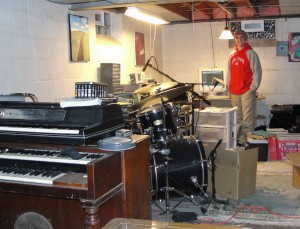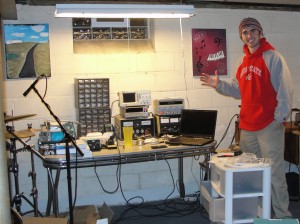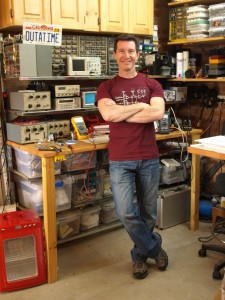Podcast: Play in new window | Download
Subscribe: Apple Podcasts | RSS
- Shout-outs
- Rich Hoeg of The Northstar Nerd, linked to us from his podcast page! Be sure to check out the others on there!
- To Google Sketchup! For offering electro-nerds the opportunity to do 3D modeling (easily!). They have a new contest in conjunction with Ponoko (thanks to @dustynrobots for the link). Check it out if interested in winning free software and stuff.Shoutouts
- Dave has used eMachineShop
- Rants
- An applications engineering job working with Labview requires a PhD?
- IEEE Salary Service isn’t included with membership fees?? What am I paying for? How are they any better than an eBook company??
- CadSoft EAGLE needs a new pricing structure. Perhaps @element14 could take a look at it and make more sense of it? Why not charge by the layer instead of the geography??
- Discussion Point
- A second edition of the NPR story on Hackerspaces played over the weekend. Mentions how MakerBot started out of NYCresistor (and the BotCave!)
- In an age of increasing hardware abstraction, is it better to be a generalist or a specialist?
- Jeri has a new video up about her (TSA Body Scanner) backscatter project. Trying to make a Hot Wheels radar gun into a 10 GHz local oscillator. This video is the first in the series and explains the background of radar.
- Dave & Chris butt heads over whether or not it will be possible to make your own practical chips at home in the future. Dave calls bullshit, Chris calls why not dude.
- New gesture software for the TI MSP430 Chronos watch. Cool idea!
- Medical devices are capable of very small form factors, such as this wand/iPhone combo for ultrasound.
- Renewable energy investment is politically/militarily driven in Isreal. Planning $500 million in investment in the next few years…wean everyone off oil and some of their adversaries have less money!
- Dave likes the plan in Australia to be 100% renewable by 2020.
- The molten salt method of storing energy could really help.
We’re still looking for submissions for Workplace (and now Workbench) of the week. If you don’t, we’ll keep posting pictures of Chris in silly hats in my lab. Please email or leave a comment on the WOTW page!


Chris and his recently re-setup lab

Thanks for listening! And let us know what you think of the music (don’t worry, Chris can take it!)

You got the date wrong in the intro, it’s Nov 30th here!
GMT m’friend. It was 10pm GMT when we started recording.
Whatever Eagle licence i’ve got allows 800 odd mm +/- of the origin. i was recently working on a PCB with a shallow curve which meant i wanted a drawing aid circle of roughly 1000mm diameter which of course Eagle didn’t want to do. I think i got the curve about right “by eye” but this sort of thing is annoying. I probably don’t ever want PCB dimensions that big. It’d be nice (is there a way?) to draw drawing aid guide lines outside the dimension limits of the licence?
Requiring a PhD for engineering positions is often code for wanting to hire foreign engineers cheap. In the US, you have to justify hiring an H1 visa, which is possible when you cannot find a US citizen “qualified” for the job. No US PhD is going to take an app engineer job.
Name another PCB CAD package of Eagle CAD quality that is $1000 or less. If my alternative is a $5000 (or $15000 or more) product with $1000/year required support license (granted, those are more feature-rich than Eagle), how is Eagle CAD expensive at $1000?
I agree that PLDs and FPGAs are how we can “make” chips at home, today, for $1 to $500 each. No home-brew fab will be able to touch that with an equivalent performance/cost ratio.
OTOH, I am convinced that if Jeri Ellsworth put her mind to it, she could make CMOS chips at home. Note, she owns a couple electron microscopes.
I used a university fab (a very long time ago) that could likely be built today for a few thousand dollars and would fit in a 3-car garage. Back then, we made 5-10 micron structures. Probably today that could be reduced, maybe approaching 1 micron.
I bet you can pick up old, mothballed-tech fab equipment for little more than the cost of hauling it away. Maybe you could reach sub-micron lines then! Note that hauling away an ion implanter likely won’t be cheap.
Of course, yields would suck and you wouldn’t beat the cost of those PLD’s and FPGAs and you also wouldn’t beat the performance, so what would be the point?
The $500 version is not cheap because you are limited to 160mm x 100mm, that is insane.
$1000 for the full version might be cheap if it suits your requirements, for sure, or it might not. That’s up to the individual.
I doubt $1000 isn’t something the average hobbyist is going to spend on a CAD package though, it’s more the small business level. And as mentioned the $500 version can be useless to many people, so you get “up sold”.
And then if you are a serious business you start thinking, well gee, maybe the more powerful $5K package might be better value…
Alternatives? Try Numberone systems:
http://www.numberone.com/prices.asp
That is the RS DesignSpark software.
Haha. Dave missed the boat on EL technology. It’s been commercial for 30 years and now it’s drop dead simple to silk screened at home or in your small company. (if you can get the materials).
Chips at home will happen someday and will be valuable. 🙂
-Jer
Dave is wrong, Jeri is right.
The point in doing your own chips? Doing it.
It is the same as with any other DIY. Why build your own power supply from parts if you can buy one? Because you can.
Hey, I agree.
If you want to make your own IC for the fun of it, sure, go out and do it, it’s almost certainly possible. I support you all the way. But that’s not what I’m talking about.
What I think is crazy is anyone who thinks it will be a viable practical solution (like the Makerbot is, and that was Chris’s comparison) when there are already hundreds of thousands of low cost parts on the commercial market that let you build anything your mind can conceive!
I wasn’t talking about EL technology, I’m talking about useful practical chips at home. Chris recons it’s just a matter of time, I recon not. Stuff like 3D printing (and EL) is pretty basic to manufacture, that’s why it’s now viable to do at home if you want. You can’t really extrapolate what’s happened with the Makerbot and say that’s inevitable wth IC’s.
Sure you might eventually be able to make some form of silicon chip at home (it might happen this year, or the next, if you are resourceful enough). That will make a great Youtube video on Hack-A-Day, but I can’t possibly see how it would be practical, or cost or time effective. Not when you can buy an ARM micro or FPGA for a few dollars, not to mention the hundreds of thousands of other devices available off the shelf from digikey et.al. All of them fully packaged, tested, characterised, cheap, and available in QTY.
Useful IC’s require so many complex manufacturing processes that are orders of magnitude more complex than say a 3D printed object or an EL display, that it will just never be practical, especially considering the plethora of commercial parts available in today’s market.
I think you’re missing the point! It’s not about whether someone at home can fab a chip just like the ones you can buy from a big company for a few cents per unit. The important issue here is the basic economic premise of the book The Innovator’s Dilemma: that a good, cheap, commonly available technology can be displaced by something that’s not so good, not so cheap, and hard to get, if it changes the rules of the game by providing a different *type* of value. Even if a large commercial fab can produce chips better and cheaper than doing it at home, they could still lose in the end if there is some value that they can’t compete on. That value could be having it available instantly, on the spot. Or the value could be having it customised to your requirements. Or something else I haven’t thought of. The point is that disruptive technologies don’t win by beating the incumbent technology or process at their own game, they win by changing the game.
My point remains the same even when you take into account “The Inventors Dilemma” as you say.
Please tell me what compelling advantage a future home made chip will have over the countless commercial chips?
I can probably think of one or two if I tried to be really creative, but they would all ultimately be so niche that it’s so far from being a game changer it’s not funny.
So my position remains the same, that home made chip in the future (which I’m sure will happen in some way shape or form) will simply not be practical or compelling enough to be of any real value to masses. It won’t change anything, nor really enable anything of universal value at all.
The Makerbot for example is not a game changer because it’s doing something radically different, it is forming a new movement by simply enabling an existing technology at a more affordable price point to the individual. The makerbot was actually inevitable because of the relative simplicity of the process of extruding plastic. Home made chips on the other hand are of such orders of magnitude more complex to produce than say an EL strip or a piece of extruded plastic, it’s just silly to think that a magical process can come along that will be a game change enabler. It all comes down the practicalities of actually producing chips that can do useful work.
Once again, those who think I’m wrong, go out and prove me wrong, really. I sincerely hope you can!
Who is David Boland? Chris mentioned it in passing when looking at the DesignSpark PCB program. Did he design that software?
Chris, don’t they have egress laws in Ohio? You couldn’t even get your cat through those windows in your basement if you had a fire. Better keep an eye on your soldering iron.
Eagle was a lot cheaper in the ’90s. I bought a 3 user license with the autorouter for less than a single seat costs now. I hope they start to realize where there bread is buttered and drop the price to something a small one or two man shop can afford because the big guys would never look twice at it.
-chrisindallas
What CAD package is everyone using? I’m graduating soon and would like to familiarize my self with something practical or useful in industry. I’ve used DipTrace, but it’s a pain in the bottom, and I want to move on.
I use EAGLE and Cadence, the former more than the latter. Other ones are Altium, OrCAD and gEDA (free). If you search for some you should be able to get trial licenses or you might be able to even get a full license as a student. Call them up and tell them you’re doing a project and want to learn their software. They like that because you would be more likely to use it later in industry since it’d be the software you know.
The major industry PCB packages are Altium, Zuken, Cadence and Mentor (not in that order).
Altium is the standard in Australia & China, less dominate elsewhere.
Altium have a student version around the $100 mark.
Zuken I believe is mostly Japan and has a poor US presence.
In the US, Altium might be one of the most popular for small to medium size firms. Larger corporations are heavily invested in Cadence & Mentor tools. So those two behemoths dominate the US market, because they do everything from PCB to chip level design.
The free packages like gEDA and KiCAD, and even Eagle are not really industry tools, so having those on the resume is of limited value.
My favourite future user interface is I-love-sketch. Check out the videos…
http://www.dgp.toronto.edu/~shbae/ilovesketch.htm
It’s amazing how the strokes and gestures of a pen can be interpretted in 3D space. I hope they get this out of lab.
Hi Dave & Chris, love the podcasts they are very entertaining. Your comments (AmpHour #19) on the DesignSpark “ASK” section are valid and we recognise that we need to change the format to make it easier to navigate. Also, just want to clarify the PCB software is completely free, and it has no limitations on size or number of layers (you can create a pcb up to a metre square, if you need to!, and have access to 14 layers). The DesignSparkPCB tool is a small part of DesignSpark.com. There is a whole load of content for design engineers on the site including free tool downloads, blogs, development kit reviews, technical content, knowledge and opinion. The site is still young, launched in July, but membership and content is building fast. We are always looking for ways to improve and appreciate your feedback.
Thanks, looking forward to the next podcast.
David, (@dtardtar)
RS is one of those companies that refuse to sell to individuals (amateurs, hobbyists) in my country. What is the point of using “free” RS software under this condition? To constantly be remind that RS doesn’t want my business?
The ironic thing is, I am an EE. Would I go to RS in my professional capacity then RS would lick their fingers to do business with my employer. However I don’t.
Because I am not welcome as an individual by RS, I also don’t see the point in joining DesignSpark to get my RS “design support” brain wash.
I’d like to hear more about how the more expensive tools better than Eagle? I’ve used Allegro, Eagle, and Mentor. They’re all different, but I don’t see the advantage to the more expensive tools. Maybe I’m not using all the advanced features.
Regarding the debate of whether IC fab can ever happen cheaply at home: Why does it need to be in your home if it gets dirt cheap? Maybe it will go the way PCBs have gone. You could get a milling machine, but it’s so easy to order PCBs cheaply and quickly.
Great show. I use Eagle and have learned how to use it through trial and error but I hate how many of the operations don’t use common Windows concepts like CTRL+C. I have been thinking about switching to one of the free ones but would hate to start the learning curve again…
Chris, the intro made me think I was listening to something on the TWIT network. 🙂
Hey Chris love the Wurlitzer 201(?) what kind of organ is that?
Hammond M3. It’s a Wurlitzer 200 (not the A apparently). I wrote about it over at my site.